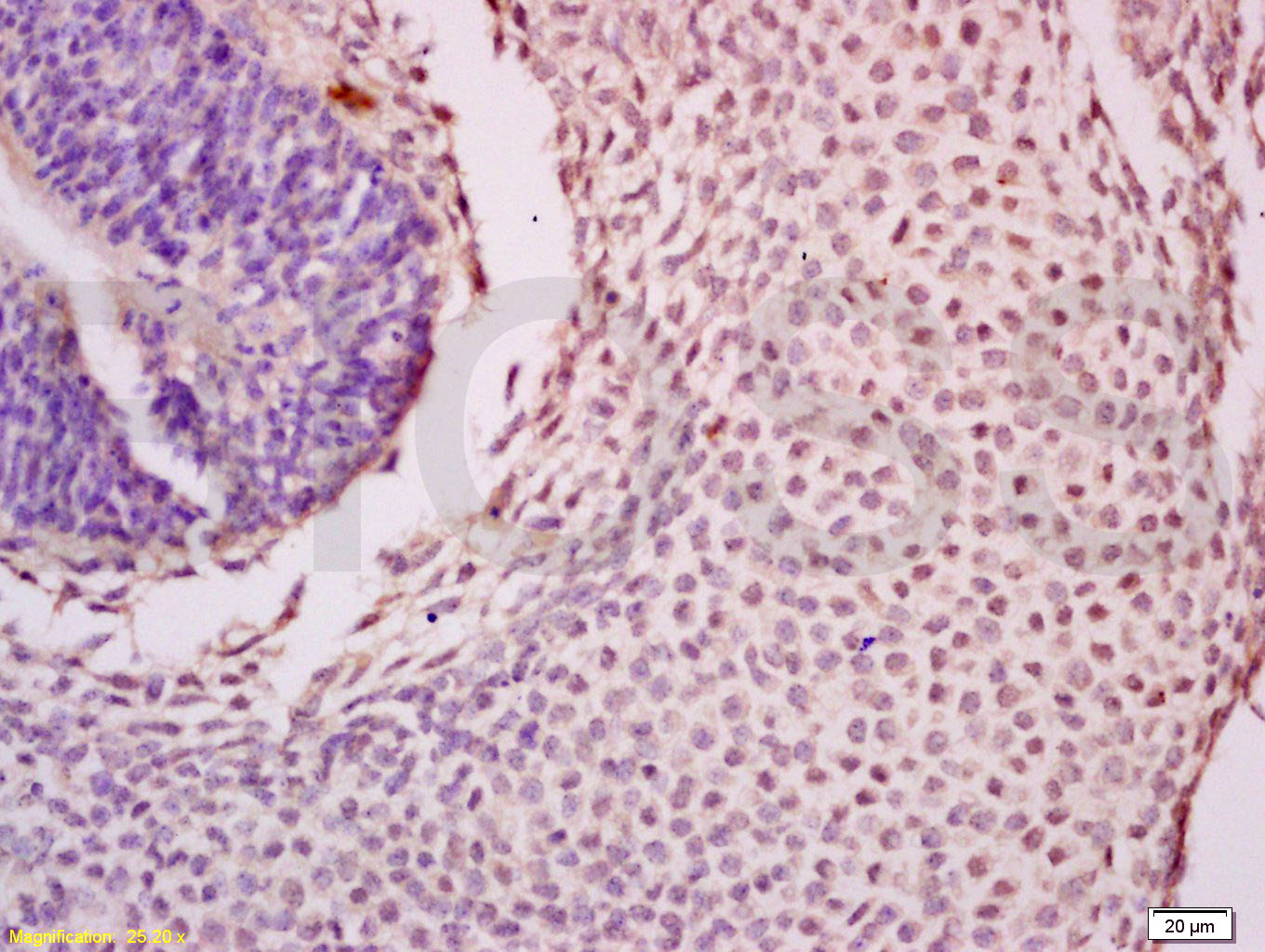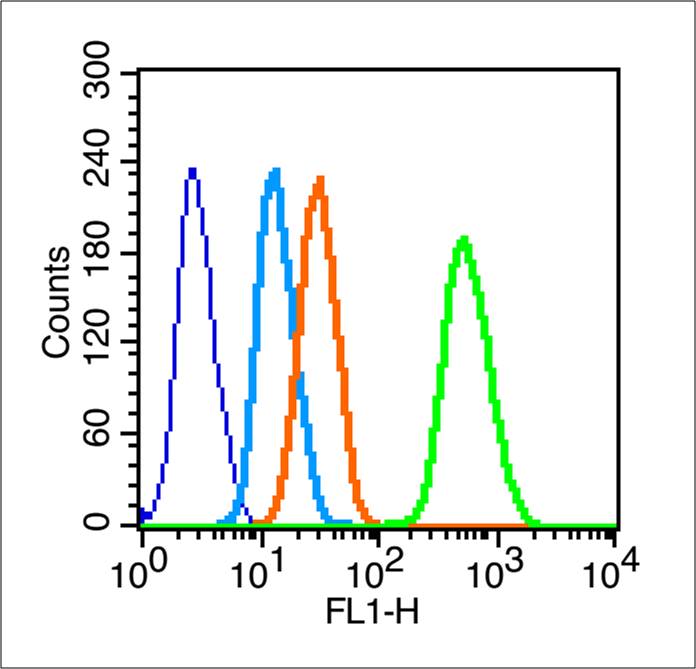
Rabbit Anti-Nanog antibody
NANOG_MOUSE; Embryonic stem cell specific homeobox protein (Nanog); ENK; FLJ12581; FLJ40451; Homeobox transcription factor Nanog; Nanog homeobox; Homeobox protein NANOG; ES cell-associated protein 4; Early embryo specific expression NK-type homeobox prote
View History [Clear]
Details
Product Name Nanog Chinese Name 胚胎Stem cells关键蛋白抗体 Alias NANOG_MOUSE; Embryonic stem cell specific homeobox protein (Nanog); ENK; FLJ12581; FLJ40451; Homeobox transcription factor Nanog; Nanog homeobox; Homeobox protein NANOG; ES cell-associated protein 4; Early embryo specific expression NK-type homeobox protein; Homeobox transcription factor Nanog; Nanog; Ecat4. literatures Research Area Tumour Chromatin and nuclear signals Signal transduction Stem cells Cyclin Cell Surface Molecule Cell differentiation Immunogen Species Rabbit Clonality Polyclonal React Species Mouse, (predicted: Human, Rat, Pig, ) Applications WB=1:500-2000 ELISA=1:5000-10000 IHC-P=1:100-500 IHC-F=1:100-500 Flow-Cyt=3μg/Test IF=1:100-500 (Paraffin sections need antigen repair)
not yet tested in other applications.
optimal dilutions/concentrations should be determined by the end user.Theoretical molecular weight 34kDa Cellular localization The nucleus Form Liquid Concentration 1mg/ml immunogen KLH conjugated synthetic peptide derived from mouse Nanog: 71-170/305 Lsotype IgG Purification affinity purified by Protein A Buffer Solution 0.01M TBS(pH7.4) with 1% BSA, 0.03% Proclin300 and 50% Glycerol. Storage Shipped at 4℃. Store at -20 °C for one year. Avoid repeated freeze/thaw cycles. Attention This product as supplied is intended for research use only, not for use in human, therapeutic or diagnostic applications. PubMed PubMed Product Detail Nanog is a newly identified homeodomain-bearing transcriptional factor. Nanog expression is specific to early embryos and pluripotential stem cells including mouse and human embryonic stem (ES) and embryonic germ (EG) cells. It is a key molecule involved in the signaling pathway for maintaining the capacity for self-renewal and pluripotency, bypassing regulation by the STAT3 pathway. Nanog mRNA is present in pluripotent mouse and human cell lines, and absent from differentiated cells. Nanog-deficient ES cells lose pluripotency and differentiate into extraembryonic endoderm lineage. Thus it is one of the molecular markers suitable for recognizing the undifferentiated state of stem cells in the mouse and human.
NANOG is a new marker for testicular carcinoma in situ and germ cell tumors.
NANOG is a gene expressed in embryonic stem cells (ESCs) and is thought to be a key factor in maintaining pluripotency. NANOG thought to function in concert with other factors such as POU5F1 and SOX2 to establish ESC identity. These cells offer an important area of study because of their ability to maintain pluripotency. In other words, these cells have the ability to become virtually any cell of any of the three germ layers (endoderm, ectoderm, mesoderm).
Function:
Transcription regulator involved in inner cell mass and embryonic stem (ES) cells proliferation and self-renewal. Imposes pluripotency on ES cells and prevents their differentiation towards extraembryonic endoderm and trophectoderm lineages. Blocks bone morphogenetic protein-induced mesoderm differentiation of ES cells by physically interacting with SMAD1 and interfering with the recruitment of coactivators to the active SMAD transcriptional complexes. Acts as a transcriptional activator or repressor. Binds optimally to the DNA consensus sequence 5'-TAAT[GT][GT]-3' or 5'-[CG][GA][CG]C[GC]ATTAN[GC]-3'. When overexpressed, promotes cells to enter into S phase and proliferation.
Subunit:
Interacts with SMAD1 and SALL4.
Subcellular Location:
Nucleus.
Tissue Specificity:
Expressed in testicular carcinoma and derived germ cell tumors (at protein level). Expressed in fetal gonads, ovary and testis. Also expressed in ovary teratocarcinoma cell line and testicular embryonic carcinoma. Not expressed in many somatic organs and oocytes.
Similarity:
Belongs to the Nanog homeobox family.
Contains 1 homeobox DNA-binding domain.
SWISS:
Q80Z64
Gene ID:
71950
Database links:Entrez Gene: 79923 Human
Entrez Gene: 71950 Mouse
Omim: 607937 Human
SwissProt: Q9H9S0 Human
Unigene: 635882 Human
研究表明;早期胚胎在没有Nanog存在的情况下是不能存活的,但是这一蛋白的表达水平至今还有待于进一步研究。学者认为:Nanog依然是一种对于生殖细胞(germ lls)形成的必要因子,Nanog也是调控着细胞融合后的多重功能的关键因子。
胚胎Stem cells是当今生命科学和生物技术研究的热点,这主要是由于其具有“发育全能性”的功能。ES能分化成人体200多种细胞类型,形成机体的任何细胞、组织和器官。通过掌握其分化发育的规律,在人工条件下定向分化为所需的细胞、组织乃至器官,科学家们希望可以用来治疗目前还难以或无法治愈的帕金森氏病、早老性痴呆、白血病、Diabetes等顽症,并且解决十分紧缺的组织和器官移植的来源问题,并且通过进一步与克隆技术相结合,运用体The nucleus转移技术来得到ES,还能解决细胞治疗以及组织和器官移植的免疫排异难题。Product Picture
Antigen retrieval: citrate buffer ( 0.01M, pH 6.0 ), Boiling bathing for 15min; Block endogenous peroxidase by 3% Hydrogen peroxide for 30min; Blocking buffer (normal goat serum,C-0005) at 37℃ for 20 min;
Incubation: Anti-Nanog Polyclonal Antibody, Unconjugated(SL0829R) 1:200, overnight at 4°C, followed by conjugation to the secondary antibody(SP-0023) and DAB(C-0010) staining
Blank control (blue line): Hela (blue).
Primary Antibody (green line): Rabbit Anti-Nanog antibody(SL0829R)
Dilution: 1μg /10^6 cells;
Isotype Control Antibody (orange line): Rabbit IgG .
Secondary Antibody (white blue line): F(ab’)2 fragment goat anti-rabbit IgG-FITC
Dilution: 1μg /test.
Protocol
The cells were fixed with 2% paraformaldehyde (10 min) , then permeabilized with 90% ice-cold methanol for 30 min on ice.Cells stained with Primary Antibody for 30 min at room temperature. The cells were then incubated in 1 X PBS/2%BSA/10% goat serum to block non-specific protein-protein interactions followed by the antibody for 15 min at room temperature. The secondary antibody used for 40 min at room temperature. Acquisition of 20,000 events was performed.
Bought notes(bought amounts latest0)
No one bought this product
User Comment(Total0User Comment Num)
- No comment




 +86 571 56623320
+86 571 56623320
 +86 18668110335
+86 18668110335

